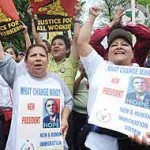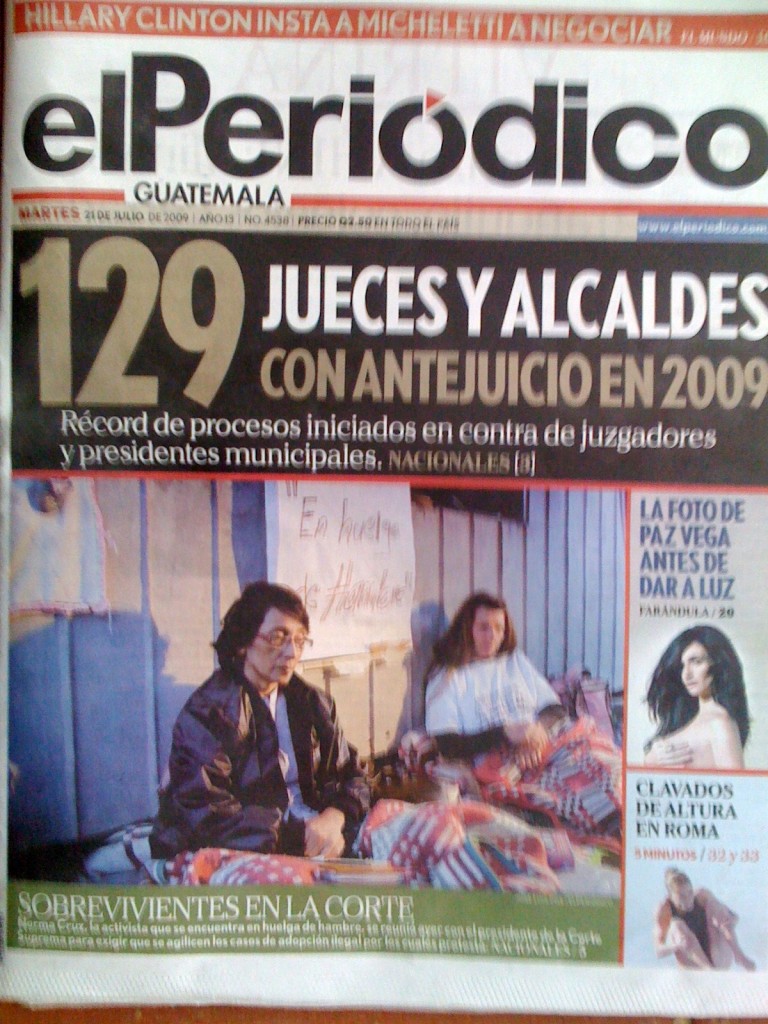Chiquita in Latin America
By NIKOLAS KOZLOFF
 When the Honduran military overthrew the democratically elected government of Manuel Zelaya two weeks ago there might have been a sigh of relief in the corporate board rooms of Chiquita banana. Earlier this year the Cincinnati-based fruit company joined Dole in criticizing the government in Tegucigalpa which had raised the minimum wage by 60%. Chiquita complained that the new regulations would cut into company profits, requiring the firm to spend more on costs than in Costa Rica: 20 cents more to produce a crate of pineapple and ten cents more to produce a crate of bananas to be exact. In all, Chiquita fretted that it would lose millions under Zelaya’s labor reforms since the company produced around 8 million crates of pineapple and 22 million crates of bananas per year.
When the Honduran military overthrew the democratically elected government of Manuel Zelaya two weeks ago there might have been a sigh of relief in the corporate board rooms of Chiquita banana. Earlier this year the Cincinnati-based fruit company joined Dole in criticizing the government in Tegucigalpa which had raised the minimum wage by 60%. Chiquita complained that the new regulations would cut into company profits, requiring the firm to spend more on costs than in Costa Rica: 20 cents more to produce a crate of pineapple and ten cents more to produce a crate of bananas to be exact. In all, Chiquita fretted that it would lose millions under Zelaya’s labor reforms since the company produced around 8 million crates of pineapple and 22 million crates of bananas per year.
When the minimum wage decree came down Chiquita sought help and appealed to the Honduran National Business Council, known by its Spanish acronym COHEP. Like Chiquita, COHEP was unhappy about Zelaya’s minimum wage measure. Amílcar Bulnes, the group’s president, argued that if the government went forward with the minimum wage increase employers would be forced to let workers go, thus increasing unemployment in the country. The most important business organization in Honduras, COHEP groups 60 trade associations and chambers of commerce representing every sector of the Honduran economy. According to its own Web site, COHEP is the political and technical arm of the Honduran private sector, supports trade agreements and provides “critical support for the democratic system.”
The international community should not impose economic sanctions against the coup regime in Tegucigalpa, COHEP argues, because this would worsen Honduras’ social problems. In its new role as the mouthpiece for Honduras’ poor, COHEP declares that Honduras has already suffered from earthquakes, torrential rains and the global financial crisis. Before punishing the coup regime with punitive measures, COHEP argues, the United Nations and the Organization of American States should send observer teams to Honduras to investigate how sanctions might affect 70% of Hondurans who live in poverty. Bulnes meanwhile has voiced his support for the coup regime of Roberto Micheletti and argues that the political conditions in Honduras are not propitious for Zelaya’s return from exile.
Chiquita: From Arbenz to Bananagate
It’s not surprising that Chiquita would seek out and ally itself to socially and politically backward forces in Honduras. Colsiba, the coordinating body of banana plantation workers in Latin America, says the fruit company has failed to supply its workers with necessary protective gear and has dragged its feet when it comes to signing collective labor agreements in Nicaragua, Guatemala and Honduras.
Colsiba compares the infernal labor conditions on Chiquita plantations to concentration camps. It’s an inflammatory comparison yet may contain a degree of truth. Women working on Chiquita’s plantations in Central America work from 6:30 a.m. until 7 at night, their hands burning up inside rubber gloves. Some workers are as young as 14. Central American banana workers have sought damages against Chiquita for exposing them in the field to DBCP, a dangerous pesticide which causes sterility, cancer and birth defects in children.
Chiquita, formerly known as United Fruit Company and United Brands, has had a long and sordid political history in Central America. Led by Sam “The Banana Man” Zemurray, United Fruit got into the banana business at the turn of the twentieth century. Zemurray once remarked famously, “In Honduras, a mule costs more than a member of parliament.” By the 1920s United Fruit controlled 650,000 acres of the best land in Honduras, almost one quarter of all the arable land in the country. What’s more, the company controlled important roads and railways.
In Honduras the fruit companies spread their influence into every area of life including politics and the military. For such tactics they acquired the name los pulpos (the octopuses, from the way they spread their tentacles). Those who did not play ball with the corporations were frequently found face down on the plantations. In 1904 humorist O. Henry coined the term “Banana Republic” to refer to the notorious United Fruit Company and its actions in Honduras.
In Guatemala, United Fruit supported the CIA-backed 1954 military coup against President Jacobo Arbenz, a reformer who had carried out a land reform package. Arbenz’ overthrow led to more than thirty years of unrest and civil war in Guatemala. Later in 1961, United Fruit lent its ships to CIA-backed Cuban exiles who sought to overthrow Fidel Castro at the Bay of Pigs.
In 1972, United Fruit (now renamed United Brands) propelled Honduran General Oswaldo López Arellano to power. The dictator was forced to step down later however after the infamous “Bananagate” scandal which involved United Brands bribes to Arellano. A federal grand jury accused United Brands of bribing Arellano with $1.25 million, with the carrot of another $1.25 million later if the military man agreed to reduce fruit export taxes. During Bananagate, United Brands’ President fell from a New York City skyscraper in an apparent suicide.
Go-Go Clinton Years and Colombia
In Colombia United Fruit also set up shop and during its operations in the South American country developed a no less checkered profile. In 1928, 3,000 workers went on strike against the company to demand better pay and working conditions. At first the company refused to negotiate but later gave in on some minor points, declaring the other demands “illegal” or “impossible.” When the strikers refused to disperse the military fired on the banana workers, killing scores.
You might think that Chiquita would have reconsidered its labor policies after that but in the late 1990s the company began to ally itself with insidious forces, specifically right wing paramilitaries. Chiquita paid off the men to the tune of more than a million dollars. In its own defense, the company declared that it was merely paying protection money to the paramilitaries.
In 2007, Chiquita paid $25 million to settle a Justice Department investigation into the payments. Chiquita was the first company in U.S. history to be convicted of financial dealings with a designated terrorist organization.
In a lawsuit launched against Chiquita victims of the paramilitary violence claimed the firm abetted atrocities including terrorism, war crimes and crimes against humanity. A lawyer for the plaintiffs said that Chiquita’s relationship with the paramilitaries “was about acquiring every aspect of banana distribution and sale through a reign of terror.”
Back in Washington, D.C. Charles Lindner, Chiquita’s CEO, was busy courting the White House. Lindner had been a big donor to the GOP but switched sides and began to lavish cash on the Democrats and Bill Clinton. Clinton repaid Linder by becoming a key military backer of the government of Andrés Pastrana which presided over the proliferation of right wing death squads. At the time the U.S. was pursuing its corporately-friendly free trade agenda in Latin America, a strategy carried out by Clinton’s old boyhood friend Thomas “Mack” McLarty. At the White House, McLarty served as Chief of Staff and Special Envoy to Latin America. He’s an intriguing figure who I’ll come back to in a moment.
The Holder-Chiquita Connection
Given Chiquita’s underhanded record in Central America and Colombia it’s not a surprise that the company later sought to ally itself with COHEP in Honduras. In addition to lobbying business associations in Honduras however Chiquita also cultivated relationships with high powered law firms in Washington. According to the Center for Responsive Politics, Chiquita has paid out $70,000 in lobbying fees to Covington and Burling over the past three years.
Covington is a powerful law firm which advises multinational corporations. Eric Holder, the current Attorney General, a co-chair of the Obama campaign and former Deputy Attorney General under Bill Clinton was up until recently a partner at the firm. At Covington, Holder defended Chiquita as lead counsel in its case with the Justice Department. From his perch at the elegant new Covington headquarters located near the New York Times building in Manhattan, Holder prepped Fernando Aguirre, Chiquita’s CEO, for an interview with 60 Minutes dealing with Colombian death squads.
Holder had the fruit company plead guilty to one count of “engaging in transactions with a specially designated global terrorist organization.” But the lawyer, who was taking in a hefty salary at Covington to the tune of more than $2 million, brokered a sweetheart deal in which Chiquita only paid a $25 million fine over five years. Outrageously however, not one of the six company officials who approved the payments received any jail time.
The Curious Case of Covington
Look a little deeper and you’ll find that not only does Covington represent Chiquita but also serves as a kind of nexus for the political right intent on pushing a hawkish foreign policy in Latin America. Covington has pursued an important strategic alliance with Kissinger (of Chile, 1973 fame) and McLarty Associates (yes, the same Mack McLarty from Clinton-time), a well known international consulting and strategic advisory firm.
From 1974 to 1981 John Bolton served as an associate at Covington. As U.S. Ambassador to the United Nations under George Bush, Bolton was a fierce critic of leftists in Latin America such as Venezuela’s Hugo Chávez. Furthermore, just recently John Negroponte became Covington’s Vice Chairman. Negroponte is a former Deputy Secretary of State, Director of National Intelligence and U.S. Representative to the United Nations.
As U.S. Ambassador to Honduras from 1981-1985, Negroponte played a significant role in assisting the U.S.-backed Contra rebels intent on overthrowing the Sandinista regime in Nicaragua. Human rights groups have criticized Negroponte for ignoring human rights abuses committed by Honduran death squads which were funded and partially trained by the Central Intelligence Agency. Indeed, when Negroponte served as ambassador his building in Tegucigalpa became one of the largest nerve centers of the CIA in Latin America with a tenfold increase in personnel.
While there’s no evidence linking Chiquita to the recent coup in Honduras, there’s enough of a confluence of suspicious characters and political heavyweights here to warrant further investigation. From COHEP to Covington to Holder to Negroponte to McLarty, Chiquita has sought out friends in high places, friends who had no love for the progressive labor policies of the Zelaya regime in Tegucigalpa.
Nikolas Kozloff is the author of Revolution! South America and the Rise of the New Left (Palgrave-Macmillan, 2008) Follow his blog at senorchichero.blogspot.com










 Malnutrition is an underlying cause in more than half of the 25,000 daily, preventable deaths of children.
Malnutrition is an underlying cause in more than half of the 25,000 daily, preventable deaths of children.


 Proud Founder Member of the Guatemala Peace and Development Network
Proud Founder Member of the Guatemala Peace and Development Network